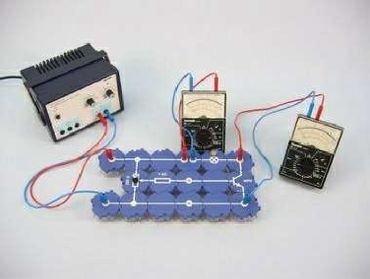The transistor as a switch  ![]() Principle The development of computer engineering and the increasing digitalisation in the transmitting and processing of information are accompanied by an increasing use of transistors for switching functions. This experiment is designed to demonstrate the basic principles of how a transistor functions as an electronic switch. We recommend that the differences between mechanical and electronic switches, and the benefits of electronic switches, be worked out with the students. The benefits of electronic switches include the low control power required, the absence of contacts (which tend to wear out in time), switching times so rapid that they are in the nanosecond range, and the small size which enables them to be fitted into integrated circuits. Benefits - No additional cable connections between the building blocks needed - clear arragned and quick setup
- Contact saftey due to puzzle blocks system
- Corrosion-free gold plated contacts
- Doubled earning sucess: Electric circuit diagram on top, real components can be seen unterside
Tasks How can a transistor be used as a switch? Investigate how the two switching conditions of a switch can be realised with a transistor. Scope of delivery |
Straight connector module, SB
|
05601-01
|
4
| |
T-shaped connector module, SB
|
05601-03
|
2
| |
Interrupted connector module with sockets, SB
|
05601-04
|
1
| |
Junction module, SB
|
05601-10
|
2
| |
Straight connector module with socket, SB
|
05601-11
|
2
| |
Angled connector module with socket, SB
|
05601-12
|
2
| |
Socket module for incandescent lamp E10, SB
|
05604-00
|
1
| |
Resistor module 1 kOhm, SB
|
05614-10
|
1
| |
Potentiometer module 250 Ohm, SB
|
05623-25
|
1
| |
NPN transistor module BC337, SB
|
05656-00
|
1
| |
Connecting cable, 32 A, red, various lengths
|
07360-01
|
1
| |
Connecting cable, 32 A, blue, various lengths
|
07360-04
|
1
| |
Connecting cable, 32 A, red, various lengths
|
07361-01
|
2
| |
Connecting cable, 32 A, blue, various lengths
|
07361-04
|
2
| |
PHYWE Analog multimeter, 600V AC/DC, 10A AC/DC, 2 MΩ, overload protection
|
07021-11
|
2
| |
PHYWE Power supply, 230 V,DC: 0...12 V, 2 A / AC: 6 V, 12 V, 5 A
|
13506-93
|
1
| |
Filament lamps 4V/0.08A, E10, 10
|
06154-03
|
1
|
|



